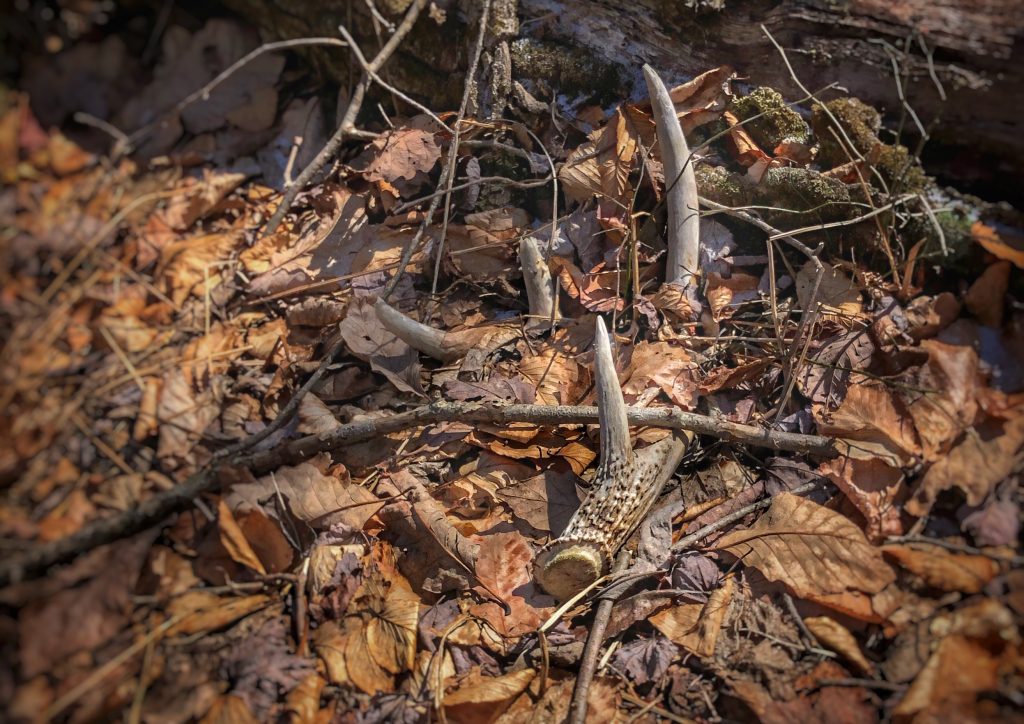I’m not alone in saying the next best thing to hunting whitetails is finding their antlers. If shed hunting isn’t on your calendar, you’re missing out. It’s the perfect springtime activity to combat couch potato blues. More importantly, shed antlers can bring you closer to understanding the keen minds of mature bucks.
Hunting antlers will take you to the hidden places you always consider going to but never do. The locations left untouched are the places that can reveal the secrets of the woods that are crucial for your future hunts.
You’ve already seen what you assume deer are doing. But will they always follow the same script? That’s a million-dollar question. Shed hunting is one of the best ways to find the answer.
Post-season Scouting
Consistently successful public land bowhunters have one major thing in common— they obsessively scout. If it pays to scout deer for hunting purposes, why not scout to hunt their antlers?
Public land is an arena for my good friend and whitetail expert, Tony Peterson. If you don’t know much about him, I’d suggest googling “Tony J Peterson” and checking out his resume. He is truly a guru. From contributing to just about every hunting publication to writing his book “Bowhunting Public Land Whitetails,” he’s been part of it all.
Beyond whitetails, Tony’s other passion is bird dogs and upland hunting. Shortly after the year-end holidays, while everyone else’s hunting seasons are coming to a screeching halt, Tony gets to work with man’s best friend. His two black labs hit the road with him on adventures that bring them straight into the heart of prime whitetail territory. Listen to dog trainer Jeremy Moore talk about shed dogs and how they help you become a better deer hunter.
Upland bird hunting may not seem related to the discovery of shed antlers, but believe me, there’s a connection. During a conversation with Tony, he told me, “I love bird hunting this time of year. There’s nothing better to get you into the places whitetails want to be. Birds aren’t where people go; neither are whitetails.”
You may have heard the term “the path of least resistance.” In the context of hunting birds, Tony stays as far from that path as possible. He describes the landscape and terrain as nothing like the type conventionally used by whitetail hunters. But the whitetail knowledge that Tony and his hunting partners have gained from trekking to those non-traditional tangles is outstanding. Deep bogs, tangled grasses, cattails, and areas almost devoid of climbable trees—half the country’s whitetail fanatics wouldn’t be caught dead wandering around in them.
Preseason Scouting
Tony’s primary stomping grounds are in Minnesota and Wisconsin. Those particular mid-western states seem to be in perpetual winter. While deep snow cover doesn’t lend itself well to finding sheds, Tony utilizes creative options. He says, “Snow patterns here vary a lot. My strategy around snow is to spot-check the places I’d like to scout after the spring thaw. Sites with active concentrated deer sign might bring me back for a return trip later in the year if I like the trending intel.”
Tony focuses his attention on the locations he finds where deer are yarding: “It’s easy to tell where deer want to be when you’re looking at their tracks in the snow. Look for those pounded trails, follow them to the food sources in the area, and make sure to mark those waypoints for return trips. If you’ve done your homework and apply what you’ve learned from scouting in the snow, you will have a real good idea of how to find their antlers.”
In-season Scouting
Shed hunting isn’t impossible in the snow. But if you’re a newbie, be advised that unless the antlers have recently fallen, they’re tough to find. For public land shed hunting, Tony feels that heading to the woods under particular conditions and on specific days of the week can help lead to success:
“Finding sheds in the snow is tough. Although you might run into one that’s a freshie, most antlers will be under that snow. For most of my public land shed hunts, I target Thursdays and Fridays. I run into fewer people those days, and deer have had the opportunity to slide back into their typical patterns before weekend warriors get back after it. If you give Thursdays and Fridays a try, line those days up with the first groundbreaking snowmelt, put in some practice, and you’ll start finding more sheds.”
Shed Hunting Advantages

As it relates to deer hunting in October, some whitetail experts are on the fence regarding whether or not finding shed antlers speaks to deer habits in the fall. If you can locate their antlers, then you’ve gained a piece of understanding. You’ll now know where that deer lives for at least some period. You also might be able to connect the dots to understand his whereabouts further.
I asked Tony his thoughts and if he believes that finding sheds relates to better hunting. His answer surprised me.
“Yeah man, it’s all the same thing! I’ve kicked up giant public land whitetails when I’m bird hunting. Every time I wonder, ‘What in the heck was that deer doing there?’ But they live in those places, and they walk through them every day. They know where to go to avoid people. Bird hunting and explicitly looking for shed antlers give you a glimpse into a buck’s everyday life. The type of stuff bucks prefer almost seems more appealing to a rabbit than a deer. But when you’re following a trail without boot tracks, get down on your hands and knees; it will be one of those ‘ah-ha’ moments. The deer sign you will see will blow you away, and it might be your time to turn up the best sheds you’ve had the opportunity to find.”